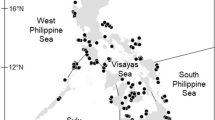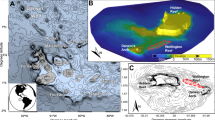Summary
Coral assemblages in northern Safaga Bay, Red Sea, Egypt, are qualitatively described. Nine distinct assemblages were found, which correspond to quantitatively defined community types previously described from the area off Hurghada, northern Red Sea. Their distribution within northern Safaga Bay was mapped. Strong gradient and/or steep relief assemblages were:Acropora assemblage on windward (exposed) reefs,Porites assemblage on leeward (sheltered) reefs,Millepora assemblage on current exposed reefs,Stylophora assemblage on reef flats. Low gradient and/or low relief assemblages were:Acropora dominated coral patches in areas of good circulation to a depth of 15 m,Stylophora/Acropora coral patch assemblages in shallow sheltered environments, faviid carpet in low relief areas between 10 and 25 m which with increasing turbidity turns into a depauperate faviid carpet,Porites carpet in low relief areas between 5 and 15 m with clearest water,Sarcophyton carpet in low relief areas with high suspension load, platy scleractinian assemblage in deeper water (>25 m) with low light intensity. The distribution of coral assemblages depends basically on 1) topography 2) hydrodynamics 3) light and 4) suspension load.
Similar content being viewed by others
References
Bak, R.P.M. &Elgershuizen, J.H.W.B. (1976): Patterns of oil-sediment rejection in corals.—Mar. Biol.,37, 105–113, 4 Figs., 3 Tables, Berlin
Benayahu, Y. &Loya, Y. (1977): Space partitioning by stony corals, soft corals and benthic algae on the coral reefs of the northern Gulf of Eilat (Red Sea).—Helgoländer wiss. Meersunters.,30, 362–382, 6 Figs., 9 Tables, Hamburg
— & — (1981): Competition for space among coral reef sessile organisms.—Bull. Mar. Sci.,31, 514–522, 5 Figs., Miami
Bosellini, F.R. &Perrin, C. (1994): The coral fauna of Vitigliano: qualitative and quantitative analysis in a back reef environment (Castro Limestone, Late Oligocene, Salento Peninsula, Southern Italy).—Boll. Soc. Paleontol. Italiana,33/2, 171–181, 7 Figs., 2 Pls., Pisa
Bosellini, F.R. &Russo, A. (1994): Coral facies across an Oligocene fringing reef (Salento Peninsula, Southern Italy). —Cour. Forsch.-Inst. Senckenberg,172, 261–264, 3 Figs., Frankfurt
Braithwaite, C. (1987): Geology and Paleogeography of the Red Sea.—In:Edwards, A.J. &Head, S.M. (eds.), Red Sea-Key Environments.—22–44, 11 Figs., London (Pergamon Press)
Coles, S.L. &Fadlallah, Y.H. (1991): Reef coral survival and mortality at low temperatures in the Arabian Gulf: new species-specific lower temperature limits.—Coral Reefs,9, 231–237, Berlin
Connell, J.H. (1978): Diversity in tropical rain forests and coral reefs.—Science,199, 1302–1310, New York
Dodd, J.R. &Stanton, R.J. (1990): Paleoecology: concepts and applications.—2nd ed., 502pp., New York (Wiley)
Done, T.J. (1982): The distribution of coral communities across the Great Barrier Reef.—Coral Reefs,1, 95–107, 9 Figs., 5 tables, Berlin
Fabricius, K.E., Benayahu, Y. &Genin, A. (1995): Herbivory in Asymbiotic Soft Corals.—Science,268, 90–92, Washington
Fagerstrom, J.A. (1987): The evolution of reef communities.— 600 pp., New York (John Wiley & Sons)
Fishelson, L. (1973): Ecological and biological phenomena influencing coral species composition on the reef tables at Elat (Gulf of Aqaba, Red Sea).—Mar. Biol.,19, 183–196, Berlin
Frost, S. (1981): Oligocene reef coral biofacies of the Vicentin, Northeast Italy.—In:Toomey, D.F. (ed.): European fossil reef models.—Soc. Econ. Paleont. Min., Spec., Publ.,30, 483–539, 19 Figs., 1 Table, Tulsa
Geister, J. (1983): Holocene West Indian Coral Reefs: Geomorphology, Ecology and Facies.—Facies,9, 173–284, 11 Pls., 28 Figs., 11 Tables, Erlangen
— (1992): Modern reef development and Cenozoic evolution of an oceanic island/reef complex: Isla de Providencia (Western Caribbean Sea, Colombia).—Facies,27, 1–70, 17 Pls., 17 Figs., Erlangen
Head, S.M. (1987): Corals and coral reefs of the Red Sea.—In:Edwards, F.J. &Head, S.M. (eds.): Red Sea-Key environments. —128–151, 16 Figs., 5 Tables, Oxford (Pergamon Press)
Highsmith, R.C. (1982): Reproduction by fragmentation in corals. —Mar. Ecol. Progr. Ser.,7, 207–226, 5 Figs., 8 Tables, Oldendorf
Hottinger, L. (1977): Distribution of larger Peneroplidae,Borelis and Nummulitidae in the Gulf of Elat, Red Sea.—Utrecht Micropal. Bull.15, 35–110, 36 Figs., Utrecht
Kleemann, K. (1992): Coral communities and coral-bivalve associations in the Northern Red Sea at Safaga, Egypt.— Facies,26, 1–10, 3 Pls., 1 Fig., 2 Tables, Erlangen
Loya, Y. (1972): Community structure and species diversity of hermatypic corals at Eilat, Red Sea.—Mar. Biol.,13/2, 100–123, 16 Figs., 8 Tables, Berlin
— (1976a): The Red Sea coralStylophora pistillata is an rstrategist. —Nature,259, 478–480, 1 Fig., London
— (1976b): Settlement, mortality, and recruitment of a Red Sea scleractinian coral population.—In:Mackie, G.O. (ed.): Coelenterate ecology and behaviour.—89–99, New York (Plenum Publishing Corp.)
— (1976c): Recolonization of Red Sea corals affected by natural catastrophies and man-made perturbations.—Ecology,57, 278–289, 12 Figs., 3 Tables, Berlin
— (1978): Plotless and transect methods.—In:Stoddart, D.R. &Johannes, R.E. (eds.): Coral reefs: research methods.— 197–217, 10 Figs., Paris (UNESCO)
Loya, Y. &Slobodkin, L.B. (1971): The coral reefs of Eilat (Gulf of Eilat, Red Sea).—Symp. zool. Soc. Lond.,28, 117–139, 10 Figs., 6 Tables, London
Mergner, H. (1977): Hydroids as indicator species for ecological parameters in Caribbean and Red Sea coral reefs.—Proc. 3rd Int. Coral Reef Symp., Miami, Florida, 119–125, 1 Figs., 1 Table, Miami
Mergner, H. &Schuhmacher, H. (1974): Morphologie, Ökologie und Zonierung von Korallenriffen bei Aquaba (Golf von Aqaba, Rotes Meer).—Helgoländer wiss. Meeresunters.,26, 238–358, 12 Figs., 20 Tables, Hamburg
— & — (1981): Quantitative Analyse der Korallenbesiedlung eines Vorriffareals bei Aqaba (Golf von Aqaba, Rotes Meer). —Helgoländer wiss. Meeresunters.,32, 476–507, 13 Figs., 20 Tables, Hamburg
— & — (1985): Quantitative Analyse von Korallengemeinschaften des Sanganeb-Atolls (mittleres Rotes Meer). I. Die Besiedlungsstruktur hydrodynamisch unterschiedlich exponierter Außen- und Innenriffe.—Helgoländer. wiss. Meeresunters.,39, 375–417, 12 Figs., 10 Tables, Hamburg
Montaggioni, L.F., Behairy, A.K.A., El-Sayed, M.K. &Yusuf, N. (1986): The modern reef complex, Jeddah area, Red Sea: a facies model for carbonate sedimentation on embryonic passive margins.—Coral Reefs,5, 127–150, Berlin
Nebelsick, J.H. (1992): The northern Bay of Safaga (Red Sea, Egypt): an actuopalaeontological approach. III. Distribution of Echinoids.—Beitr. Paläont. Österr.,17, 5–79, 8 Pls., 37 Figs., 6 Tables, Wien
Pandolfi, J.M. (1984): Environmental influence on growth form in some massive tabulate corals from the Hamilton Group (Middle Devonian) of New York State.—Paleontogr. Americana,54, 538–542, 3 Figs., Ithaka
Pandolfi, J.M. &Burke, C.D. (1989): Environmental distribution of colony growth form in the favositidPleurodictyum americanum.—Lethaia,22, 69–84, 9 Figs., Oslo
Pätzold, J. (1984): Growth rhythms recorded in stable isotopes and density bands in the reef coralPorites lobata (Cebu, Philippines).—Coral Reefs,3, 81–89, Berlin
Perrin, C., Bosence, D. & Rosen, B. (1995): Quantitative approaches to paleozonation and paleobathymetry of corals and coralline algae in Cenozoic reefs.—In:Bosence, D.W.J. & Allison, P.A. (eds.): Marine Paleoenvironmental Analysis from Fossils.—Geol. Soc. Spec. Publ.,83, 181–229, 25 Figs., 2 Tables, London
Pianka, E.R. (1970): On r- and K-selection.—Am. Nat.,104, 592–597, Chikago
Piller, W.E. (1994): The northern Bay of Safaga (Red Sea, Egypt): an actuopalaeontological approach. IV. Thin section analysis.—Beitr. Paläont.,18, 1–73, 18 Pls., 19 Figs., 5 Tables, Wien
Piller, W.E. &Pervesler, P. (1989): The northern Bay of Safaga (Red Sea, Egypt): an actuopalaeontological approach. I. Topography and bottom facies.—Beitr. Paläont. Österr.,15, 103–147, 10 Pls., 8 Figs., 1 Table, Wien
Piller, W.E. &Mansour, A.M. (1990): The northern Bay of Safaga (Red Sea, Egypt): an actuopalaeontological approach. II. Sediment analyses and sedimentary facies.—Beitr. Paläont. Österr.,16, 1–102, 55 Figs., 19 Tables, Wien
Reiss, Z. &Hottinger, L. (1984): The Gulf of Aqaba. Ecological Micropaleontology.—VIII +354 pp., Berlin, (Springer)
Riegl, B. (1989): Gesellschaftsstruktur von Steinkorallen (Scleractinia) an Riffen des nördlichen Roten Meeres.— unpubl. Diplomarbeit, Universität Wien, 120 pp., Wien
— (1995a): A revision of the hard coral genusAcropora Oken 1816 (Scleractinia: Astrocoeniina: Acroporidae) in south-east Africa.—Zool. J. Linn. Soc.,113, 249–288, 12 Figs., London
— (1995b): Effects of sand deposition on scleractinian and alcyonacean corals.—Marine Biology,121, 517–526, 6 Figs., 3 Tables, Berlin
Riegl, B. &Velimrov, B. (1994): The structure of coral communities at Hurghada in the Northern Red Sea.—PSZNI Marine Ecology,15/3–4, 213–231, 8 Figs., 3 Tables, Berlin
Riegl, B. &Branch, G.M. (1995): Effects of sediment on the energy budgets of four scleractinian (Bourne 1900) and five alcyonacean (Lamouroux 1816) corals.—J. exp. Mar. Biol. Ecol.,186, 259–275, 3 Figs., 3 Tables, Amsterdam
Riegl, B. &Bloomer, J.P. (1995): Tissue damage in scleractinian and alcyonacean corals due to experimental exposure to sedimentation.—Beitr. Paläont.,20, 51–63, 4 Pls., 2 Tables, Wien
Rosen, B.R. (1971): Principal features of reef coral ecology in shallow water environments of Mahé, Seychelles.—In:Stoddart, D.R. & Yonge C.M. (eds.): Regional Variation in Indian Ocean Coral Reefs.—Symp. Zool. Soc. Lond.,28, 163–183, London
— (1975): The distribution of reef corals.—Rep. Underwat. Ass., (N.S.)1, 1–16, London
— (1977): The depth distribution of recent hermatypic corals and its paleontological significance.—Mem. Bur. Rech. Geol. Minieres,89, 507–517, 3 Figs., 1 Table, Paris
Rosen, B.R. (1981): The tropical high diversity enigma—the coral’s eye of view.—In:Greenwood, P.H. & Forey, P.L. (eds.): Chance, Change and Challenge. The evolving biosphere.—Brit. Mus. (Nat. Hist.) and Cambridge Univ. Press, 103–129, London
Scheer, G. &Pillai, C.S.G. (1984): A report on the stony corals of the Red Sea.—Zoologica,133, 1–198, 41 Pls., 5 Figs., Stuttgart
Schuhmacher, H. &Mergner, H. (1985): Quantitative Analyse von Korallengemeinschaften des Sanganeb Atolls (mittleres Rotes Meer). II. Vergleich mit einem Riffarael bei Aqaba (nördliches Rotes Meer) am Nordrande des indopazifischen Riffgürtels.—Helgoländer wiss. Meeresunters.,39, 419–440, 4 Figs., 4 Tables, Hamburg
Sheppard, C.R.C. & Sheppard, A.L.S. (1991): Corals and coral communities of Arabia.—Fauna of Saudi Arabia,12, 170pp., 189 Figs., Basel
Sheppard, C.R.C., Price, P. &Roberts, C. (1992): Marine Ecology of the Arabian Region.—347 pp., London (Academic Press)
Thomason, J.C. &Brown, B. (1986): The Cnidom: an index of aggresive proficiency in scleractinian corals.—Coral Reefs,5, 93–101, 9 Figs., 1 Table, Berlin
Vellmirov, B. (1973): Orientiertes Wachstum beiMillepora dichotoma (Hydrozoa).—Helgoländer wiss. Meeresunters.,26, 18–26, 6 Figs., Hamburg
Veron, J.E.N. (1986): Corals of Australia and the Indo-Pacific. —633 pp., North Ryde (Angus & Robertson)
Veron, J.E.N. & Pichon, M. (1976): Scleractinia of Eastern Australia. Part 1. Families Thamnasteriidae, Astrocoendiidae, Pocilloporidae.—Aust. Inst. Mar. Sci. Monogr. Ser.,1, 86 pp., 166 Figs., Canberra
Veron, J.E.N. & Pichion, M. (1979): Scleractinia of Eastern Australia. Part 3. Families Agariciidae, Siderastreidae, Fungiidae, Oculinidae, Merulinidae, Mussidae, Pectiniidae, Caryophylliidae, Dendrophyliidae. —Aust. Inst. Mar. Sci. Monogr. Ser.,4, 422pp., 857 Figs., Canberra
Veron, J.E.N. & Pichon, M. (1982): Scleractinia of Eastern Australia. Part 4. Family Poritidae.—Aust. Inst. Mar. Sci. Monogr. Ser.,5, 159 pp., 346 Figs., Canberra
Veron, J.E.N., Pichon, M. & Wijsman-Best, M. (1977): Scleractinia of Eastern Australia. Part 2. Families Faviidae, Trachyphyllidae. —Aust. Inst. Mar. Sci. Monogr. Ser.,3, 233 pp., 477 Figs., Canberra
Veron, J.E.N. & Wallace, C.C. (1984): Scleractinia of Eastern Australia. Part 5. Family Acroporidae.—Aust. Inst. Mar. Sci. Monogr. Ser.,6, 485 pp., 1292 Figs., Canberra
Author information
Authors and Affiliations
Rights and permissions
About this article
Cite this article
Riegl, B., Piller, W.E. Distribution and environmental control of coral assemblages in northern Safaga Bay (Red Sea, Egypt). Facies 36, 141–162 (1997). https://doi.org/10.1007/BF02536881
Received:
Revised:
Issue Date:
DOI: https://doi.org/10.1007/BF02536881




